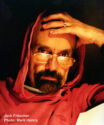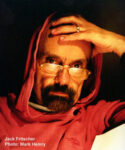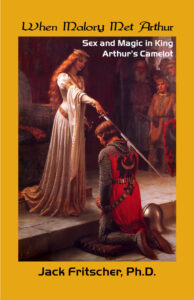Chapter also available in PDF
Ad Rem: A Brief Critical Digest
To place the text, the prime consideration, in proper perspective, a brief summary of scholarly positions may help clarify a basic critical debate concerning Malory’s secular or religious intent in constructing his prose work, Morte Darthur. The camps are basically two: the literal secularization in the texts of Vinaver versus the organic literary theology of Charles Moorman and Robert Lumiansky. The chain shot for both are the sources, but they aim to a difference of Malorian textual conclusion.
General agreement on the sources has been established by Vinaver’s extensive investigation of fifteenth-century French Arthurian texts. His conclusion is that Malory’s immediate French source has lost identification; he projects, however, that the prose cycle of the thirteenth century “had a Merlin, a Suite de Merlin or Livre d’Artus…a Lancelot…, possibly a Gareth, a Tristan, a Queste del Saint Graal, a Mort Artu….[1] At any event, Geoffrey of Monmouth and the Anglo Norman Wace had secured the Arthurian materials in early form; the lyrics of Chretien de Troyes injected the Acquitainian courtly love element; and the Cistercian writers detailed the Grail story into a barely digestible theological tract streaming a trail of thickset allegory.
These writers used the Arthurian material as a vehicle. Geoffrey, for instance, wanted to be remembered as authentic historian; the Cistercians had their theological disputations. It remained for Malory to make the Arthurian material more than quasi-historic and apologetic material. It remained for Malory to make it literature and to ground the narrative dimensionally in a hearty metaphor.
Vinaver sees Malory very much a modern in sympathy and idiosyncrasy: “For the medieval courtly idealism he [Malory] attempts to substitute the philosophy of a practical and righteous fifteenth-century gentleman; and where the French romantic writers seek to set forth an ideal remote from reality he sees but a moral doctrine to be followed by all those who desire honor…in this world.”[2] But once again Vinaver goes not far enough in allowing to Malory only a moral system that is this-worldly. As a result Vinaver finds Malory to have written an interesting secular pageant with no integrated religious, that is transcendent, motif. The Grail exists as no mystic symbol; Galahad’s birth is no “act of redemption and purification,” but is “an ordinary event in family life.”[3] F. Whitehead agrees with Vinaver that to treat Morte Darthur “as though it were an improving religious work, as though it discussed courtly morality in the light of the doctrine of the Grail, or even as though it showed the world and its vain joys dissolving into nothingness…[is] to place emphasis where Malory has resolutely refused to put it.”[4]
Moorman in contradistinction to Vinaver believes that Malory did indeed understand the French Queste. He agrees with Vinaver that Malory made extensive cuts. But unlike Vinaver, who oversimplifies that Malory’s excisions from the Queste form in themselves a tidy theological treatise and that the passages were omitted because Malory had small concern for the religious implications of the Queste, Moorman maintains that Malory works always to cut away all unnecessary material be it religious or secular. The key word is unnecessary. Thus in summarizing, especially his homiletic excisions, Malory “always preserves the core of the French books’ doctrinal statements, no matter how great his deletions.”[5] Malory is not therefore trying to secularize his sources, but only to make them tractable out of their vast intransigence. He uses or omits according to what is necessary or unnecessary for the overall plan of his Arthurian cycle: his constant pattern is to adapt and create material specific and thematically relevant to his narrative.
If Malory were a Vinaverian secularist one could hardly explain away the instances in which he adds to the religious content through supernatural additions. Twice, for instance, the voice commanding Galahad is depicted as supernatural in order to heighten both the spiritual authority of the command and Galahad’s own religious characterization. In the French source Galahad’s commands had been voiced by mere mortals. In addition, Lancelot’s highest test of religious faith and stature is in the episode, original with Malory, of the supernatural healing of the slain knight Urry.
Vinaver, however, may have called attention to an essential characteristic of Malory’s mind in stressing a secularizing tendency, but one must interpret this. Malory does not secularize so much the genuinely supernatural as he does the merely pietistic and homiletic. He does not so much reject religion as tone down any highly esoteric mysticism. There is a difference. The while he may have enjoyed “little of the theological subtlety of the French source…he by no means shared the [highly specified] pre-occupation of the French monastic author.”[6] The point is he condensed the theological debates while adding points of his own to the total effect that the balanced critic must admit that Malory, recognizing the importance of the socio-moral religious code, had a genuine theological consciousness as far removed from secularism as genuine piety is from pietism. All this in a work not meant to be a two-penny catechism.
Therefore in his cultural tradition Malory necessarily saw human life as primarily an ethical problem of normal Christian morality. The Middle Ages more than modern times lived hyper-consciously at a point of Christian paradox. Malory resolved the resulting tension with a fine distinction; one must accept the “relative unattainability of the best without becoming dissatisfied with the good.”[7] This is the difference between his Galahad and his Lancelot, and it is the lesson both his characters and his fifteenth-century readers received. Perhaps it was his English practicality that enabled Malory to temper, beneath essentially the same narrative, the extremes of his sources into a balanced bedside book for the aristocratic reader.
Malory and his artist’s mind, conditioned by his time —one of transition from simple theological to psychological respect for man—effected in his art a statement of this very transition; for out of psychological respect for the reader, Malory made rather subliminal but quite pervasive the theology of his Morte Darthur. All this in a work meant to be literature.
-
E.K. Chambers, English Literature at the Close of the Middle Ages (New York: Oxford University Press, 1947), p. 189. ↑
-
Vinaver, Malory, p. 109. ↑
-
Vinaver, Malory. p. 83. ↑
-
F. Whitehead, Essays on Malory, p. 112. ↑
-
Charles Moorman, “Malory’s Treatment of the Sankgreal,” PMLA, LXXI (1956), 498; hereafter cited as Moorman, PMLA. ↑
-
Arthur B. Ferguson, The Indian Summer of English Chivalry: Studies in the Decline and Transformation of Chivalric Idealism (Durham, N.C.: Duke University Press, 1960), p. 53; hereafter cited as Feruuson. ↑
-
Ferguson, p. 54. ↑


